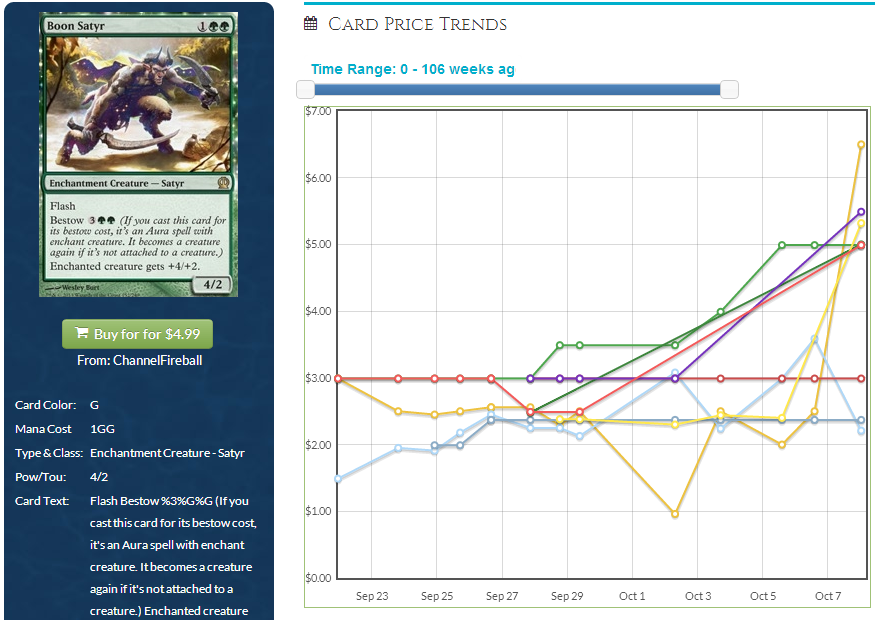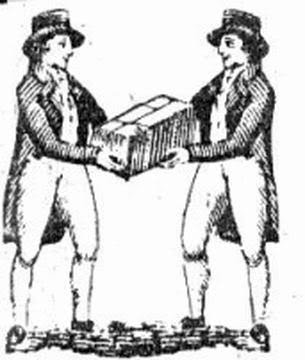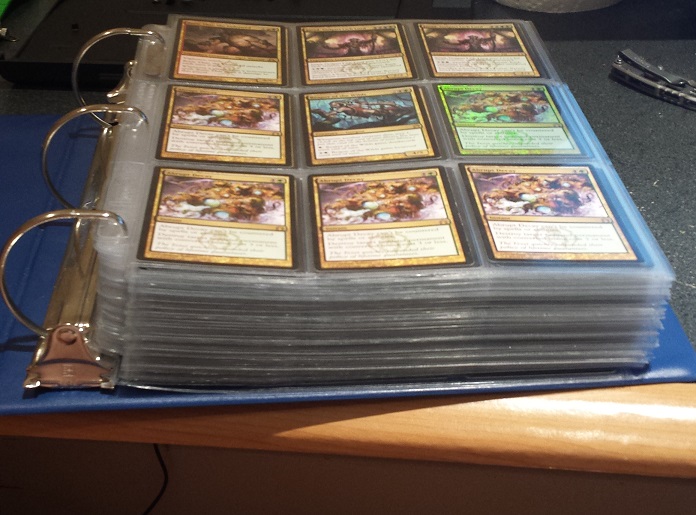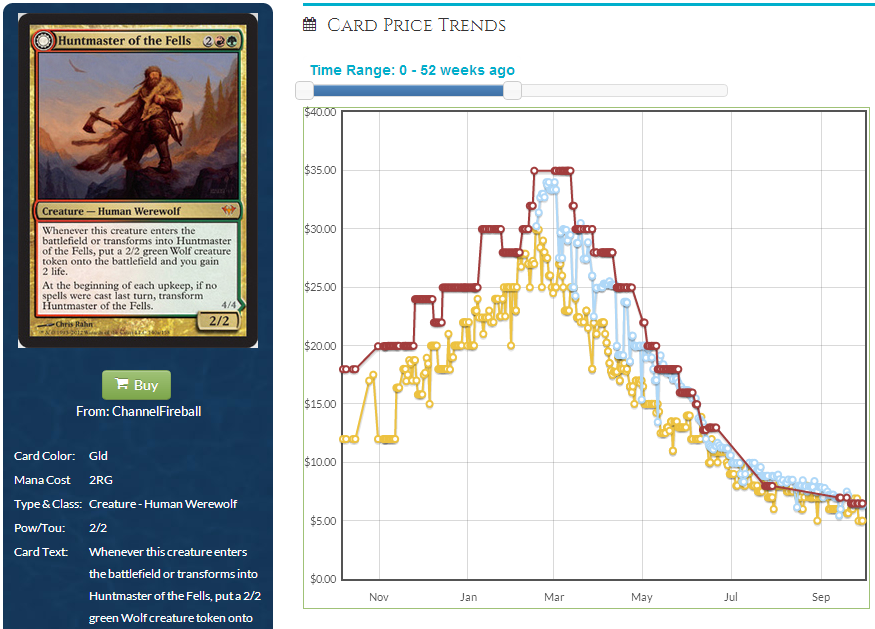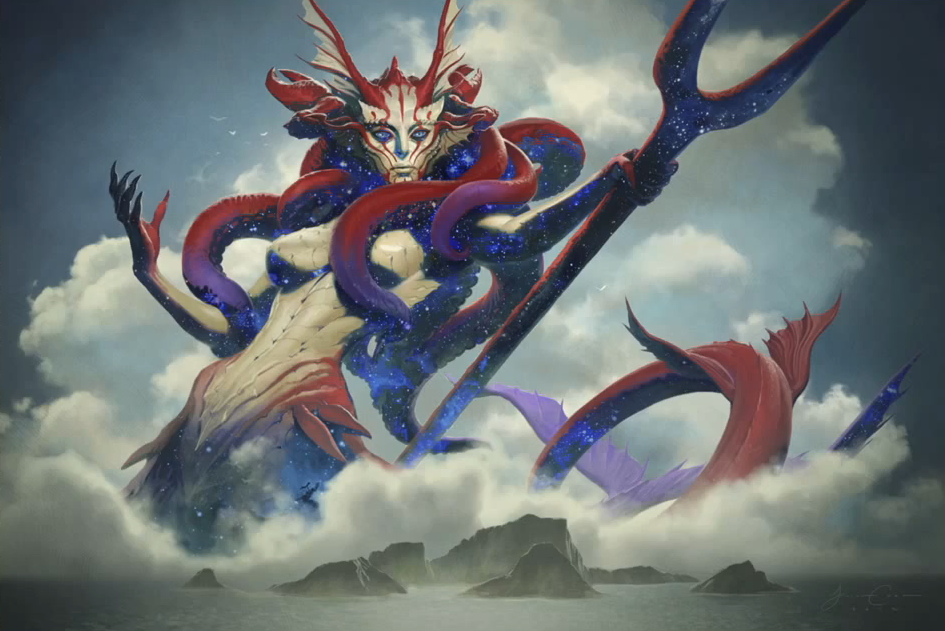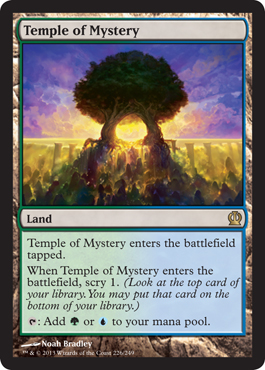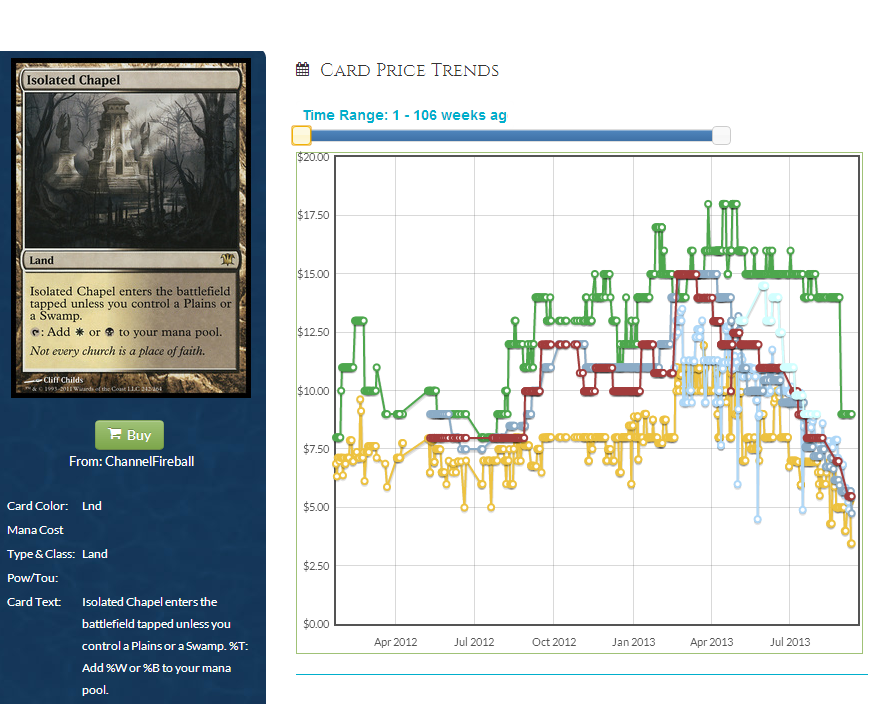My goal with card reviews is to approach them a bit more holistically. Considering the card, what conditions it needs to be good, and how those factors impact costs is very much in the fish-teaching school, of which I am a big fan. Hopefully this Theros review will illuminate for you my evaluation process so that you can understand how to make informed trade and purchase decisions throughout the life of the set.
Any card I don’t mention is one that either I consider total bulk or I don’t feel that I have anything particularly helpful to add.
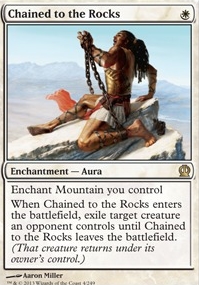
Chained to the Rocks: Chained to the Rocks is poised to be one of the strongest removal spells in the format, especially with how good decks with Sacred Foundry look at the moment. I see it available for about $2.50 on TCG Player as of 9/23/13, which likely is fairly close to its floor. Mizzium Mortars never really sunk below $2 retail, and I think Chained compares pretty well. The ceiling on this card isn’t particularly high though. While it’s quite a powerful effect, you still need to have actual Mountains (and a good deal of them) to use it, not just lands that tap for red, such as Clifftop Retreat. I can’t imagine this breaking $5 for longer than a week or two, if ever. The best strategy regarding this card will simply be picking them up in trade for $1-$2 and trading them away at $3-$4.
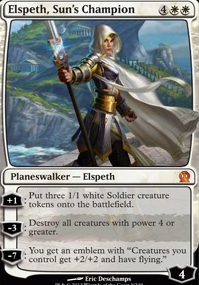
Elspeth, Sun’s Champion: Between Garruk, Caller of Beasts and this new Elspeth, Wizards is obviously not messing around with six mana Planeswalkers anymore. Elspeth is indisputably powerful. The question here will not be “is she strong enough,” but rather “is she strong enough for her cost relative to other options.” I feel like of any six mana Planeswalker, she has the best chance to be a major force in Standard. Not only does she protect herself when she comes down, she does an excellent job of it, and quite possibly the result of two back-to-back +1s is that you have more creatures than your opponent. In conjunction with her pseudo-wrath ability, you have a Planeswalker that can stabilize on turn 6 with either ability and then start driving towards a pretty quick victory immediately after.
Her applicability is not even necessarily restricted to control. Similar to Garruk, Primal Hunter, she may also play well as a strong alternative threat in a midrange strategy. Admittedly, unlike Primal Hunter, she doesn’t draw you cards. She does however present a different vector than simply slamming other efficient creatures. While her path to victory does include the red zone (unlike, say, Jace, Memory Adept), she keeps churning attackers out turn after turn. On the whole her path to victory isn’t as much of a deviation from a creature strategy as you may want it to be, but the sheer strength of her abilities may be able to overcome that for a midrange deck.
Elspeth is still in that Planeswalker honeymoon period of $30+. Given her high mana cost, I anticipate it may take a little longer before she starts showing up in decklists. I’m guessing she may pull a Gideon Jura though, where people are lukewarm at first, playing only one copy, but then adding more and more. I’ll be keeping a close watch on her price and quantity of appearances in T8 decklists. If she shows up as a one-of in the maindeck of a winning list and the author talks about how great she was, expect positive movement. Like most Planeswalkers, if she dips below $15 it is time to start seriously considering picking her up in trade.
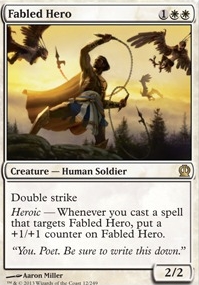
Fabled Hero – Aside from having possibly the best flavor text in the set, Fabled Hero is another “dies to Doom Blade” face smasher. He doesn’t protect himself, but as long as you have one more guy than they have removal spell, he kills real quick. I expect he’ll see light to moderate play, depending on how good the heroic support is. If the format ever reaches a point where spot removal is weak, even if only for a single weekend, his stock rises significantly.
I would expect his price to typically hang out in the $1-$3 range on any given weekend, but spiking an event could jump him to $6+ pretty easily. If Brave the Elements targeted, then we’d be in another ballpark. Even still, I think this is the type of card that can oscillate pretty easily. I wouldn’t be surprised to see him dip, jump, dip, and jump again all within his journey through Standard.

Gift of Immortality: Intro deck rare. I love the card, but do not buy into this with the intent of profit.
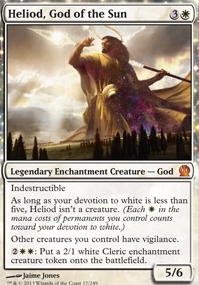
Heliod, God of the Sun: Heliod reads to me as the second weakest of the five gods. Vigilance is one of the weaker combat keywords, compared to Trample/Flying/Haste. Low white curves do tend to be heavy on mana symbols though (think Precinct Captain,) so Heliod may be able to spend a reasonable amount of time as powerful threat. His activated ability also provides aggressive white decks an outlet for mana late in the game. Two power on tokens is also a lot larger than one. A lot. As in, the first time someone starts cranking those out against you, you’re going to be amazed at how much more effective they are than you expected them to be.
The gods are a little tricky financially. They’re almost-sorta a new card type, and subsequently I don’t feel like I have a good gauge for how their casual support is going to be. If I had to take a guess (which I suppose I do since I’m writing this article), it’s that the gods in general will be more popular with the casual crowd than the average decent mythic. I feel like the floor on Heliod – and all the gods – is probably around $5-7. Their upside is easily over $20, but there will have to be tournament results to support that. I wouldn’t expect to see that anytime soon, so feel free to ditch any copies you picked up at the prerelease.
My opinion on the gods, and other cards in general of which I’m not confident in my predictions, is to ship them early and wait until I understand them better. There’s always another card to make money on, so staying away from an unknown quantity is perfectly acceptable.
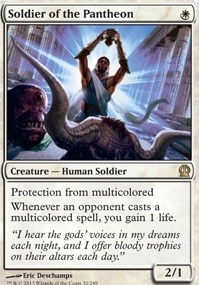
Soldier of the Pantheon: Boy, Savannah Lions has come a long way, huh? Remember that we just came out of Ravnica, so “Protection from multicolored” reads a little better now than it will in a year. It will still probably be in discussion for any Modern white weenie deck, so if you can find Craig Wescoe, you know you’ve got a buyer. Other than that, your white one drop has to see heavy, sustained play (think Champion of the Parish) to maintain a $4+ price tag.

Artisan of Forms: Artisan seems very weak to me. These days, a ton of the value in good creatures is their ETB effect, which Artisan doesn’t get you. You also have to do a lot of work to even get the clone effect. Bulk rare; trade away accordingly.
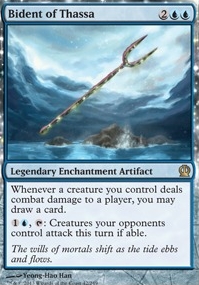
Bident of Thassa: Release promo. Bulk.
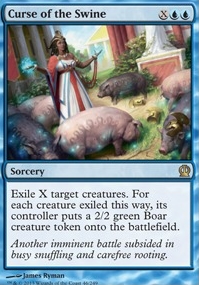
Curse of the Swine: Bulk, unless they reprint Aether Flash.
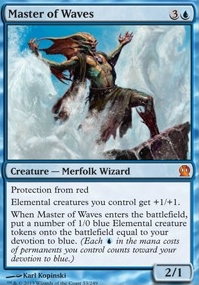
Master of Waves: I have a lot of trouble seeing Master accomplish much. Blue token makers are fairly rare, but creatures that die when their Master dies just seem miserable. Given the current state of blue, what permanents do you have in play that give you a healthy amount of devotion that are not already putting the game away for you?
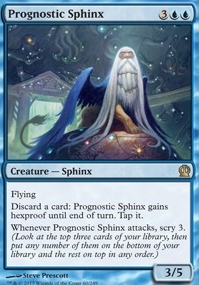
Prognostic Sphinx: THE TEEF will never be a four-of. I’d say $2 at his absolute best.
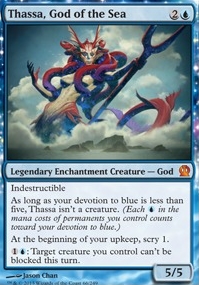
Thassa, God of the Sea: I believe Thassa is quietly the best god in the set. Purphorous and even Erebos are getting a lot of chatter, but most Thassa discussion has been less high-energy. However, I believe this is due in part to people underestimating the power of scrying every upkeep. In discussions with other players, the common opinion seems to be that the fair yet still playable cost for an enchantment that was just the upkeep scry would be 1U. That effectively means you’re getting the entire rest of the card for one colorless mana. Not competing with Jace or Supreme Verdict on the mana curve is also a great position to be in. When you finally do get Jace down, all it takes is UU somewhere to suddenly be within range of closing the game out fast. Notice that Thassa is capable of making herself unblockable.
Of all the gods, Thassa is the one I’m most interested in financially. If she ever does get below $10, I’ll start grabbing as many in trades as possible. I think it will take time for the format to begin including her, so there will hopefully be a window where she’s under-priced.
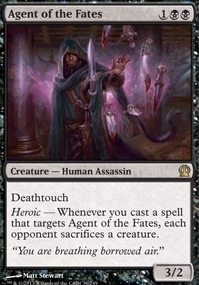
Agent of the Fates: This card seems fantastic to me. The base stats of 3 power for 1BB is respectable, if not exciting. Adding deathtouch gives you a creature that is almost always relevant in combat. Then you tack on the Heroic ability and the power level of this card becomes worth discussing. The very first time you target Agent with a spell, you have immediately gotten a Cruel Edict for free, which is worth two mana. Even if they respond with removal, they’re down two cards (creature + removal) for your two cards (Agent + targeted spell.) Nobody says you have to play this on turn three, either. Running him out on turn four allows you to retain priority once he resolves, immediately giving you one mana to target with. Not to mention what happens if they actually don’t have the removal spell, which will certainly happen a reasonable amount of time.
Agent of the Fates loves Warriors’ Lesson, which is already good enough to see play on its own merits. How about Hidden Strings? Tap your best guy, untap my Agent (heroic!), cipher onto Agent, deal three, cast Hidden Strings, Tap your whatever and untap my Agent (heroic!)
Agent of the Fates is $2 on TCG Player while I write this, which is almost low enough for me to just start buying copies. If he gets under $1, he will be a major trade target, and under $.50 I’ll start in with cash.
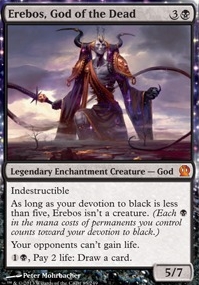
Erebos, God of the Dead: Erebos has been the second most popular god so far, and I’m pretty sure that is due entirely to people not realizing how high of a cost his draw is. Two life is not an insignificant amount of life to pay to draw a single extra card. Yes, it’s repeatable, but the toll adds up fast. The ability is strongest late in the game, when both players are already limping. I don’t think the ability worthless, but I get the impression people read the words “draw a card” and ignored everything to the left of the colon. On top of that, his static anti-lifegain clause goes from “highly disruptive” to “niche ability” with Thragtusk rotating.
Erebos seems poised to see a pretty heavy drop off in demand. I’d get out now and not look back.
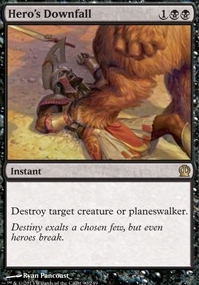
Hero’s Downfall: Domri Rade is going to find himself on the business end of a minotaur hoof frequently in the coming months. Hero’s Downfall will be a major factor in the forthcoming Standard landscape. Murder was always “almost,” and adding ‘Planeswalker’ to the card text will definitely push it over the edge. That said, I don’t see much of a reason for this to deviate from the Mizzium Mortars/Dreadbore path. I expect it to spend a very stable life hovering in the $2-$5 range. Your profit here will be trading for them at $2 and then trading them away at $4. If black ends up being the best color in Standard, the top end here may be as high as $6 or $7. (There is also no chance I call this anything other than Murderbore for the next two years.)
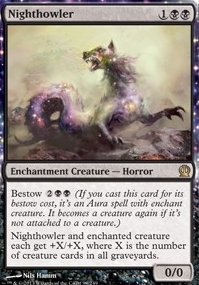
Nighthowler: Possibly playable card that I doubt will ever crest a dollar. I bring it up because it’s the Game Day Top 8 promo, and it looks super sweet. The promo will likely hold value better than it’s playability would have you believe because of this.
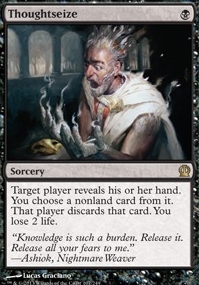
Thoughtseize: There’s really not too much to say here. Thoughtseize is and will be a Standard, Modern and Legacy staple. Expect Snapcaster-esque prices for the next two years.
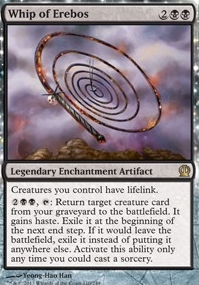
Whip of Erebos: Cool card that’s in an intro deck. If it hits the Standard scene, don’t look to profit on this, but rather the other cards it will be dragging out of graveyards. And yes, it does work as well with Obzedat as you’d like it to.
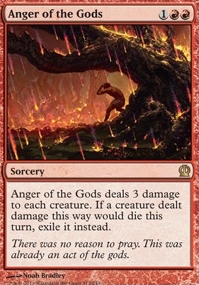
Anger of the Gods: Possibly a better Slagstorm depending on what you’re in the market for, and an effect we have been desperately in need of. (Take that, you lousy Burning-Tree Emissary decks.) This has bonus points for being impactful in Modern. I see no reason to expect much price behavior different from Murderbore.

Firedrinker Satyr: Maybe it’s because I’m not a Jackal Pup kind of guy, but I really don’t care for this much at all. I’d ship these fast and avoid down the road. People tend to remember old cards, or new cards similar to old cards, a little too fondly in vastly different formats than when they were originally good. Remember when Nantuko Shade was like $8 preorder or something?

Hammer of Purphoros: Solid looking card, but falls into the Koth trap of mostly being only good in really heavy red decks. Even if the card is fantastic, how many Hammer of Purphoros decks can there really be? I wouldn’t take the risk of trying to make money here; there’s better places to put your gaming bux.
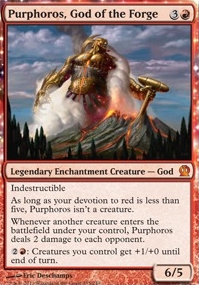
Purphoros, God of the Forge: I will say right now that I am less enthralled with Purphoros than many others are. One thing that I can’t look past is that he feels like the type of card that typically has one “right” deck at any given time. He may be phenomenal in that deck, but an all-star in a single deck in a single format is going to have a very real price ceiling. I don’t doubt that he’s very powerful, but $25 will be a very difficult price tag to maintain amidst a lot of other very competitive-looking mythics such as all three Planeswalkers, Stormbreath Dragon, and Thassa.
For what it’s worth, I also don’t think he’s the top-end of a very aggressive deck. Aggressive red decks want their four drop to be capable of ending the game on the spot: Hero of Oxid Ridge, Hellrider, Falkenrath Aristocrat, etc. Even if you resolve him on turn four and he’s instantly a creature, he still can’t attack right away. Purphoros seems more at home in a big red/Boros style list, where you can continue making creature drops after he resolves. I wouldn’t be surprised to see him alongside Boros Reckoner and Stormbreath Dragon in the near future.
In any case, I’d be trading these away ASAP. The odds that he loses a lot of value are far greater than he gains any. If he slips towards $10, feel free to start grabbing them, because someone will probably give him a breakout performance at some point.

Stormbreath Dragon: This card is the real deal. Compare to Thundermaw Hellkite: both are flying hasty five drop dragons. We lose one point of power and toughness, which is for sure not irrelevant. Protection from White is going to be better than tapping all fliers in many situations, especially because it dodges Azorius Charm, Chained to the Rocks, Detention Sphere, and many fliers for the rest of the game instead of just once (nice Angel of Serenity. You’re still dead.) In fact, looking through every creature in the format with flying, there are close to zero that are nonwhite. Shadowborn Demon, I guess?
Last but certainly not least is the monstrous ability. Without monstrous, Stormbreath is already doing a very good Thundermaw impression. Once we add monstrous, our dragon is looking very threatening. Seven mana may seem like a lot, but with cards like Xenagos and Satyr Hedonist capable of providing small mana bumps, and plenty of other reasons to want to be capable of generating large amounts of mana (Polukranos, Ember Swallower, Fleecemane, etc), we may find ourselves with a very frightening dragon more often than not. The extra damage from the cards in our opponent’s hand isn’t even particularly important most of the time. Just turning him into a 7/7 is absurd enough.
As I see it, Stormbreath is poised to step in and assume Thundermaw’s role without missing a beat. Preorders have jumped from $15 to $25, and I don’t think that’s an unreasonable number for him to hang around at. Thundermaw hit $50 for a period, and if Stormbreath comes out of the gate terrorizing heros, I would expect no different. At this point he’s too expensive to buy into to spec on, but if you want a set, I wouldn’t hesitate to trade for him. I doubt you stand to lose much, and his upside is very high. If he dips below $15 again, I’d start snatching them wherever possible.

Boon Satyr: I want to cast this card strictly so that I can say “you’ve been boondoggled” when I kill someone with him. Even though there’s a lot of chatter about Boon Saibot, he’s still only $2 right now. Keep in mind that Loxodon Smiter has seen significant play in Standard and has even broken into Modern yet is still currently only about $4. There’s a real limit to how expensive an in-print rare can be. It will be tough for Boon Satyr to maintain a price over $4-$5 while he’s in the current set even if he’s seeing excessive Standard play. However, if he is consistently putting up results over the next year or is prevalent at the Theros Block Pro Tour, look to start snatching them up next summer when he’ll be at a low.

Nylea, God of the Hunt: Nylea is widely considered to be the weakest of the gods. I’m not entirely convinced that is true, but she certainly has an uphill climb to prove otherwise. On the one hand green decks that will want trample are likely to be strong devotion enablers, and she’s a solid beater herself. The activated ability feels very weak to me however. She’s $9 right now, and I expect that to start slipping very quickly. I’d say $4 is her absolute floor though, so if she gets that low don’t be afraid to grab a few sets. Even if she never gets there in Standard, it’s likely the gods will always maintain solid casual demand.
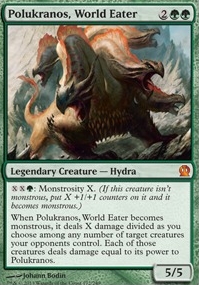
Polukranos, World Eater: Polukranos is a powerful card that is going to be responsible for a lot of dead 2/2s and 3/3s. He’s in the Duel Deck though, so his price has a firm ceiling. While I’m seeing copies under $5, I’d guess is floor is around $2.50. If he slips under $3, there’s a lot of room for potential profit there with little downside. I also wouldn’t hesitate to trade for a set now for personal use, as again there isn’t that much to lose.
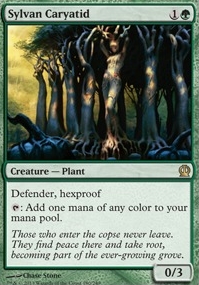
Sylvan Caryatid: Caryatid is the Buy-A-Box promo. Without even having to read a single piece of card text, let’s take a quick look at past BaBs:
M14: Ratchet Bomb (Standard Playable)
Dragon’s Maze: Render Silent (Unknown, but not yet)
Gatecrash: Nightveil Specter (Block Playable, possibly Standard)
Return to Ravnica: Supreme Verdict (Standard Playable)
M13: Cathedral of War (No Considerable Play)
Avacyn Restored: Silverblade Paladin (Standard Playable)
Dark Ascension: Gravecrawler (Standard Playable)
Innistrad: Devil’s Play (Standard Playable)
M12: Chandra’s Phoenix (Standard Playable)
New Phyrexia: Surgical Extraction (Standard Playable)
Mirrodin Besieged: Mirran Crusader (Standard Playable)
Scars of Mirrodin: Memoricide (Standard Playable)
M11: Birds of Paradise (Standard Playable)
Rise of Eldrazi: Guul Draz Assassin (No Considerable Play)
Worldwake: Celestial Colonnade (Standard Playable)
Zendikar: Day of Judgment (Standard Playable)
M10: Honor of the Pure (Standard Playable)
This list of every BaB promo shows that Wizards has a great track record for making the card relevant in Standard. I have no reason to suspect Caryatid will behave otherwise. As a two drop mana dork, my biggest concerns about this card are Supreme Verdict and Anger of the Gods. Your mana dorks are frequently at their best on turn one, which obviously isn’t an option here. It’s possible you may not even be able to tap this for mana once before your opponent wraths it away. Having said that, the extra cost buys you some real versatility relative to Birds of Paradise.
A lot of people expect Caryatid to be a major part of the standard landscape, and I agree. She (?) is currently right around $5, which sounds a tad high. Like Daniel Boone, I expect there will be money to be made on Caryatid next summer.
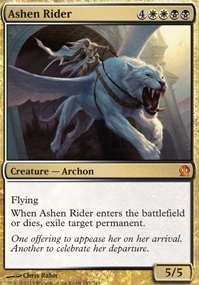
Ashen Rider: Probably won’t be too expensive, but foils will command a premium. If it ends up being a 4-of in Obzedat’s Aid/Erebos’ Whip type decks, the price could quintuple very quickly though.
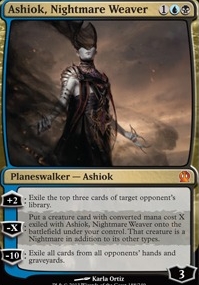
Ashiok, Nightmare Weaver: Many players I’ve spoken to are not wild about Ashiok, but I am quite confident Ashiok will be a part of the Standard landscape. On turn three, Ashiok ticks up to five, making Ashiok a tough kill. If your opponent doesn’t remove Ashiok, you simply untap, let Ashiok do Ashiok’s thing, and use your mana to protect Ashiok. Being able to steal creatures out of midrange decks will be quite helpful in wars of value and attrition, while threatening to obliterate a control player’s resources is a real threat indeed. Ashiok will be at Ashiok’s worst against highly aggressive decks, but that is not uncommon for Planeswalkers. I’ll let more tournament-minded players speak in-depth about Ashiok’s strength, but suffice to say I am on board.
Ashiok is still rather pricey at ~$18. I anticipate Ashiok cratering pretty quickly, as it may take time for Ashiok to find Ashiok’s way into lists. Once the number is below $10, I will gladly start picking up Ashiok in trade.

Daxos of Meletis: If a single thing on this card was missing, I’d be proclaiming it bulk. As is though, Daxos seems to have a lot of intriguing puzzle pieces. The can’t-be-blocked clause means it may be a lot easier to get through than we realize. Suiting up in a single Ethereal Armor makes Daxos a nightmare to block profitably, if at all. The life gain will be very relevant against plenty of opponents, especially if you’re sometimes gaining four or five life. Finally, being able to cast off-color cards may occasionally be supremely powerful – UW casting Murderbore will be fantastic. At $2, I’m not interested. If Daxos slips below $.50 though, I’ll definitely consider acquiring aggressively depending on if he’s appeared in any results. When a card ends up below $.50, the risk is just so low and the profit potential so high.
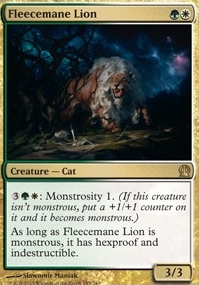
Fleecemane Lion: This could end up being the most overpriced card in the set. We already have something better than Watchwolf at the moment (Call of the Conclave) and nobody is playing it. The monstrosity clause is almost surely better than the state of being a token, but is it by any meaningful amount? Decks that play Watchwolf want to put guys into play and attack with creatures like Stormbreath Dragon, not spend their turn five mana to do one extra damage in a format full of good edict effects. There will be games where the monstrosity wins the game, but plenty more where you’ll wish you had just played Scavenging Ooze instead. I sold mine at the prerelease; I recommend you do the same.
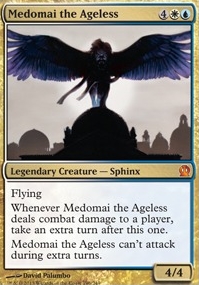
Medomai the Ageless: Nifty card that is almost surely unplayable in Standard. Foils will be worth a bunch for EDH.
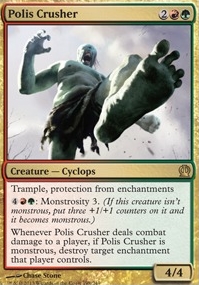
Polis Crusher: Potentially great card but he’s in an intro deck. It’s possible someone will manage to make money on him, but it won’t be me.
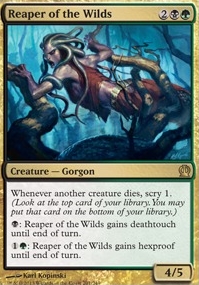
Reaper of the Wilds: This is my card seems to have a great deal of financial potential. There were only two other creatures in RtR that had three activated abilities: Deathrite Shaman and Lotleth Troll. I hope I don’t need to explain Deathrite, and I don’t believe we’ve seen the last of Lotleth either.
A 4/5 for four is not a thrilling rate of return, but it’s only a single point of power away from the now-industry standard 5/5 for four model (Deadbridge Goliath, Polukranos.) Getting to scry every time a creature dies means that as you remove opposing bodies, Reaper helps keep the flow of removal and threats going. Your first Doom Blade helps find the second one.
The ability to gain deathtouch keeps him relevant in combat throughout the game, and conditional hexproof turns spot removal into a losing proposition. I don’t think this card will necessarily be a major player in Standard for two years, but I do think it will see enough play to warrant a several dollar price tag at some point. Like Daxos, if this slips under $.50, consider me a buyer.
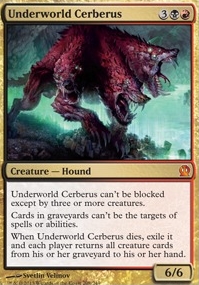
Underworld Cerberus: Cerberus is one of those cards that has a lot of disconnected moving parts that makes him tremendously difficult to properly evaluate. Cards like this are notorious for being misunderstood early on because of their complexity, only to shoot up in playability (and price) once people realize just how powerful they are.
Woofy is the only mythic rare in the set that has a real chance of seeing a considerable and sustained rise from his prerelease price, and the only mythic I’ll be trading for at FNM this week. I’m not sure exactly if he’s good enough, but I know his ceiling is higher than his floor is low.
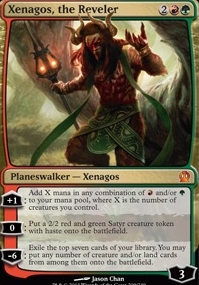
Xenagos, the Reveler: My initial reaction to this card was quite poor. He read like a four mana satyr generator. As spoiler season marched on though, I began to see potential. His +1 ability is inconsequential in many decks – but not all. I’ve read several reviews that seem to focus on him as a ramp enabler, but I believe this is only a surface-level application, and ultimately not what Wizards had in mind, at least for his initial purpose. Rather than ramping into huge fatties that would otherwise be tough to cast, we want to find a way to squeeze usefulness out of an additional two to four mana a turn. You know what loves a few extra mana? Monstrosity.
Xenagos won’t even be the best GR Planeswalker in Standard, but he’s not as bad as I expected early on. His success will hinge largely on the playability of monstrous and monstrous-esque creatures. Expect Xenagos, Polukranos and Stormbreath Dragon to be best buds this fall. A safe price to trade in at will be $12 or so. I wouldn’t be surprised to see him follow Chandra’s price curve.
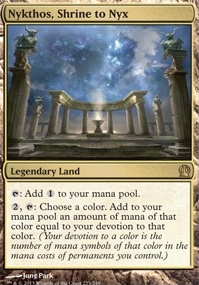
Nykthos, Shrine to Nyx: You need at least three devotion to break even on tapping this land, which is not a trivial hurdle. I can’t imagine this having much of an impact in standard. Even if it does make it into Standard, what are the odds it shows up in more than one list? Due to EDH, I see this as a $1-2/$10 nonfoil/foil split. Even if EDH drives up the nonfoil price, it will take years to happen. Get rid of all yours, pick up a foil one for EDH, and don’t look back.
The Scry Lands: I wrote all about this last week. Tl;dr: buy under $3, which is where they will be shortly.
In summary, the cards I recommend you pay most attention to, in no particular order:
1. Underworld Cerberus
2. Agent of the Fates
3. Reaper of the Wilds
4. Ashiok, Nightmare Weaver

